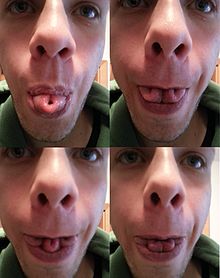Tongue rolling

Tongue rolling is the ability to roll the lateral edges of the tongue upwards into a tube. The tongue's intrinsic muscles allow some people to form their tongues into specific shapes. Rolling the tongue into a tube shape is often described as a dominant trait with simple Mendelian inheritance, and it is commonly referenced in introductory and genetic biology courses, although there is some disagreement.[1]
Genetics
Prevalence in human populations varies between 65% and 81%.[2]
There is no statistically significant sexual dimorphism in this trait. A 1940 study by Alfred Sturtevant analyzed 282 people of mostly European ancestry and observed that 67.1% of females and 62.9% of males could roll their tongues, and the remaining could not do it.[3] A 1980 study with 992 people also found similar percentages, in 66.84% of females and 63.7% of males possessing the ability.[4]
In some cases, the ability can be learned by practice, more easily by children, but also by adults. For this reason, studies should allow time for individuals to learn this and other abilities. This also indicates that it's not a simple hereditary trait, and there are other factors involved.[2][3][5]
In the first paper about this trait as a genetic trait, Sturtevant concluded that the ability "is conditioned at least in part by heredity", and suggests that "it is possible, though not proved, that ability to turn up the edges of the tongue may be due to a single dominant gene, with the fairly frequent occurrence of additional complications".[3][6] These findings, however, have been questioned.
Several twin studies on the issue have been conducted. A 1952 study involving 33 pairs of identical twins found that 21% of them were discordant - that is, one of the twins had the ability and the other did not.[7] A 1971 study found that identical twins were 18% discordant, and 22% of non-identical twins were discordant, concluding that "hereditary factors strongly influences tongue rolling ability".[8] However, a 1975 found that identical twins were 28% discordant, while 31% of non-identical twins were discordant, and concluded that identical twins were no more likely than fraternal twins to both have the same phenotype for tongue rolling.[9]
One explanation for the pattern is that the trait has incomplete penetrance. That is, not every individual with the genes can express the trait.[10]

Related abilities
Cloverleaf tongue is the ability to fold the tongue in a certain configuration with multiple bends. This trait has been speculated by David D. Whitney in 1950 to be a dominant trait inherited separately from tongue rolling.[11]
Other tongue ability is folding the tip of the tongue upwards, which has been proposed as a recessive trait in a 1948 study, with possible epistatic interaction with the rolling gene.[5][11]
Twisting the tongue has also been studied, which is to rotate the tongue approximately 90 degrees from the plane of the blade, both to the right and to the left.[5]
A 1980 study analyzed if there was any interaction between ear wiggling and tongue rolling, and found it to be the case for males, with men more likely to have both abilities or none, but no interaction was found for females.[4]
In popular culture
In This Is Us, an adopted teenager asks strangers to roll their tongues in an attempt to locate his biological family using genetics.[12]
In the Powerpuff Girls episode "Nuthin' Special", while searching for a unique super power not shared by her sisters, Buttercup finds out she is the only one that can roll her tongue.[13]
See also
References
- ^ Mader SS (2000). Human Biology (6th ed.). Boston: McGraw-Hill. ISBN 978-0-07-290584-7.
- ^ a b McDonald JH (December 8, 2011). "Myths of Human Genetics: Tongue Rolling". udel.edu. Retrieved 2023-01-05.
- ^ a b c Sturtevant AH (February 1940). "A New Inherited Character in Man". Proceedings of the National Academy of Sciences of the United States of America. 26 (2): 100–102. Bibcode:1940PNAS...26..100S. doi:10.1073/pnas.26.2.100. PMC 1078012. PMID 16588317.
- ^ a b Hernandez M (1980). "La movilidad del pabellon auditivo". Trab. Antropol. XVIII (4): 199–203.
- ^ a b c Hirschhorn HH (May 1970). "Transmission and learning of tongue gymnastic ability". American Journal of Physical Anthropology. 32 (3): 451–454. doi:10.1002/ajpa.1330320315. PMID 5419380.
- ^ "Observable Human Characteristics". Genetic Science Learning Center - Learn.Genetics. 2016. Retrieved 5 January 2022.
- ^ Matlock P (January 1952). "Identical twins discordant in tongue-rolling". Journal of Heredity. 43 (1): 24. doi:10.1093/oxfordjournals.jhered.a106251 – via OUP.
- ^ Reedy JJ, Szczes T, Downs TD (March 1971). "Tongue rolling among twins". The Journal of Heredity. 62 (2): 125–127. doi:10.1093/oxfordjournals.jhered.a108139. PMID 5165087.
- ^ Martin NG (May 1975). "No evidence for a genetic basis of tongue rolling or hand clasping". The Journal of Heredity. 66 (3): 179–180. doi:10.1093/oxfordjournals.jhered.a108608. PMID 1236879.
- ^ Praxedes LA, Otto PA (December 2000). "Estimation of penetrance from twin data". Twin Research. 3 (4): 294–298. doi:10.1375/136905200320565265. PMID 11463150.
- ^ a b "Tongue Curling, Folding, Or Rolling". OMIM - Online Mendelian Inheritance in Man. Retrieved 2023-01-05.
- ^ Bamber J (6 February 2017). "'This Is Us' "The Trip" Explores the Past to Cast Light on the Present". PopMatters. Retrieved 2023-01-05.
- ^ Emma Majoros (13 March 2021). "Powerpuff Girls: 10 Things You Never Knew About Buttercup". Gamerant.